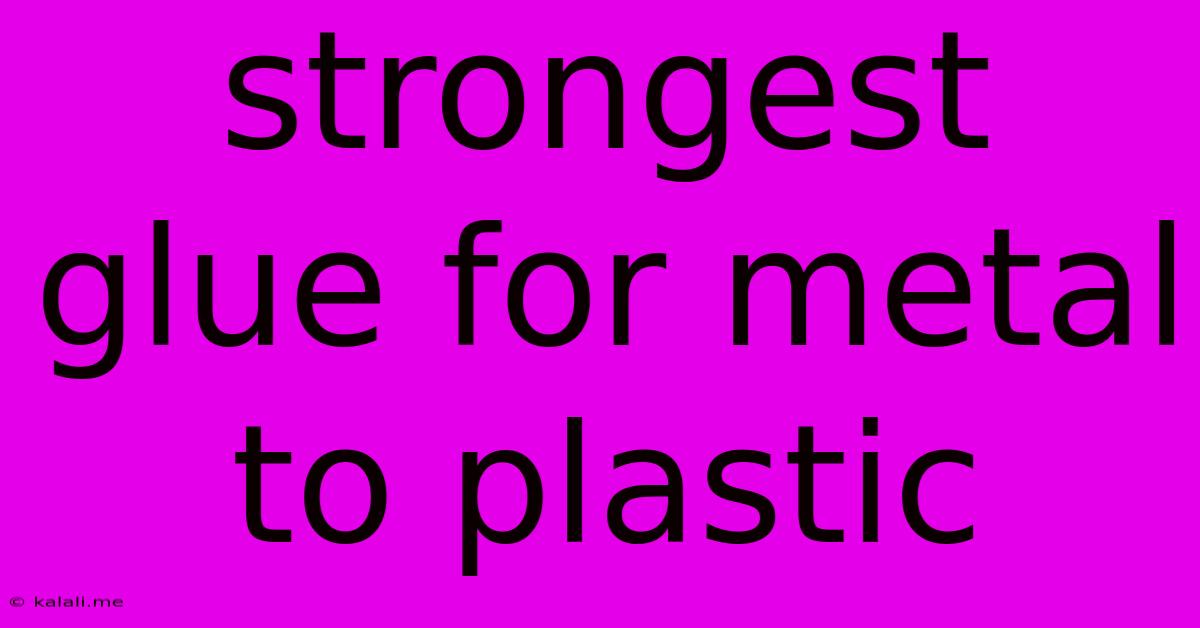Strongest Glue For Metal To Plastic
Kalali
May 22, 2025 · 4 min read

Table of Contents
Finding the Strongest Glue for Metal to Plastic: A Comprehensive Guide
Meta Description: Bonding metal to plastic can be tricky, but this guide explores the strongest adhesive options available, comparing their strengths, weaknesses, and best applications. Learn how to choose the right glue for a lasting, reliable bond.
Choosing the right adhesive for bonding metal to plastic can be a daunting task. The challenge lies in the inherent differences between these two materials: metals are generally rigid and strong, while plastics can be more flexible and susceptible to chemical reactions. This means a "one-size-fits-all" solution simply doesn't exist. The ideal glue depends heavily on the specific types of metal and plastic involved, the application's stress levels, and the environmental conditions. This comprehensive guide will help you navigate the options and select the strongest glue for your specific needs.
Understanding the Challenges of Metal-to-Plastic Bonding
Before diving into specific adhesives, it's important to understand why bonding metal to plastic is more complex than bonding similar materials. The key challenges include:
- Surface Energy Differences: Metals typically have higher surface energy than plastics. This difference can affect the adhesive's ability to wet and adhere properly to both surfaces.
- Thermal Expansion Mismatch: Metals and plastics expand and contract at different rates when exposed to temperature fluctuations. This can create stress on the bond, leading to failure over time.
- Chemical Compatibility: Certain adhesives may react negatively with specific metals or plastics, weakening the bond or causing corrosion.
Types of Adhesives for Metal-to-Plastic Bonding
Several adhesive types offer varying degrees of strength and suitability for metal-to-plastic applications. Let's explore some of the strongest contenders:
-
Epoxy Adhesives: Epoxies are known for their exceptional strength, versatility, and resistance to various chemicals and environmental factors. Two-part epoxy systems offer superior bonding strength compared to one-part epoxies. They are a great choice for high-stress applications, but require careful mixing and curing. Look for epoxies specifically formulated for metal-to-plastic bonding.
-
Cyanoacrylate (Super Glue): Cyanoacrylates, commonly known as super glue, offer fast curing times and good initial strength. However, they are generally less durable than epoxies and may not be suitable for high-stress or high-temperature applications. Their strength can also be affected by the surface preparation of the materials.
-
Acrylic Adhesives: Acrylic adhesives provide a good balance of strength, flexibility, and ease of use. Some acrylic formulations are specifically designed for metal-to-plastic bonding and offer good resistance to environmental factors. They typically require less clamping pressure during curing compared to epoxies.
-
Polyurethane Adhesives: These adhesives are known for their toughness and flexibility, making them suitable for applications where vibration or shock is a concern. However, their strength might not match that of epoxies in high-stress situations.
-
Structural Adhesives: This category encompasses a range of high-strength adhesives designed for demanding applications. These often require specialized application techniques and may need professional installation.
Factors Affecting Adhesive Strength
The ultimate strength of the bond isn't solely determined by the adhesive itself. Several crucial factors play a significant role:
- Surface Preparation: Thorough cleaning and preparation of both metal and plastic surfaces are paramount. This often involves degreasing, sanding, and possibly priming to ensure optimal adhesion.
- Gap Filling: A tight bond is generally stronger. Choose an adhesive with appropriate gap-filling properties if there's a noticeable gap between the surfaces.
- Curing Time: Allow sufficient curing time for the adhesive to reach its maximum strength. This time varies depending on the specific adhesive and environmental conditions.
- Temperature and Humidity: Extreme temperatures and humidity can affect the curing process and the long-term durability of the bond.
Choosing the Right Adhesive: A Practical Approach
Selecting the strongest glue requires careful consideration of your specific application. Ask yourself:
- What materials are you bonding? (Specific metal and plastic types are crucial.)
- What stress levels will the bond endure? (Vibration, shock, tensile strength, etc.)
- What environmental conditions will the bond be exposed to? (Temperature, humidity, chemicals)
- What is your budget and the required curing time?
By carefully considering these factors and the information presented above, you can choose the strongest and most appropriate glue for your metal-to-plastic bonding project. Remember, proper surface preparation and adhering to the manufacturer's instructions are vital for achieving a long-lasting, high-strength bond.
Latest Posts
Latest Posts
-
Not By The Hair Of My Chinny Chin Chin
May 22, 2025
-
How To Fix A Door Lock That Won T Turn
May 22, 2025
-
Where To Find Aluminum Fallout 4
May 22, 2025
-
What Can I Use Instead Of Coconut Oil
May 22, 2025
-
After Thawing Chicken How Long Is It Good For
May 22, 2025
Related Post
Thank you for visiting our website which covers about Strongest Glue For Metal To Plastic . We hope the information provided has been useful to you. Feel free to contact us if you have any questions or need further assistance. See you next time and don't miss to bookmark.